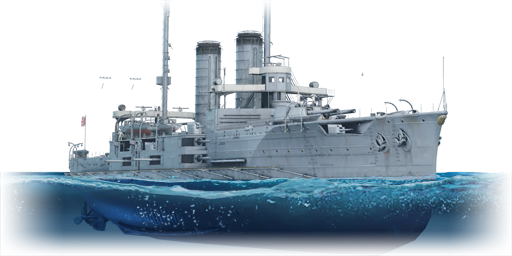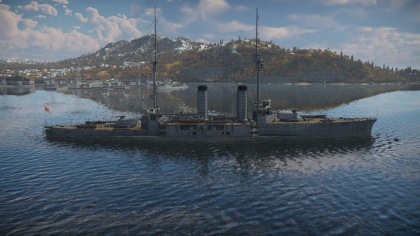Difference between revisions of "IJN Ikoma"
(Edits) |
(→Pros and cons: backups) (Tag: Visual edit) |
||
| Line 73: | Line 73: | ||
There is no effective AA armament, and aircraft can easily come down to mast height to accurately deliver bombs, rockets or torpedoes. You can only hope the rest of your team has enough AA to provide some protection. The 3 armoured decks can absorb a lot of punishment from smaller bombs, but any armour piercing bombs, or anything from 1,000 lb/500 kg upwards will cause significant damage. At this BR, heavier bombs such as 1,800 kg, 4,000 lb and 5,000 kg are common loads, and can destroy the ship with 1 or 2 hits. | There is no effective AA armament, and aircraft can easily come down to mast height to accurately deliver bombs, rockets or torpedoes. You can only hope the rest of your team has enough AA to provide some protection. The 3 armoured decks can absorb a lot of punishment from smaller bombs, but any armour piercing bombs, or anything from 1,000 lb/500 kg upwards will cause significant damage. At this BR, heavier bombs such as 1,800 kg, 4,000 lb and 5,000 kg are common loads, and can destroy the ship with 1 or 2 hits. | ||
| + | |||
| + | Backups for this ship cost only 10 GE - cheap enough so that it is better to buy them than use universal backups - you should always use them when grinding. | ||
=== Modules === | === Modules === | ||
| Line 122: | Line 124: | ||
* Powerful 12" main armament can wreck anything less than a battleship with a few hits; | * Powerful 12" main armament can wreck anything less than a battleship with a few hits; | ||
* Heavy secondary armament of 6" and 4.7" guns is sufficient to destroy destroyers and smaller when controlled by the player; | * Heavy secondary armament of 6" and 4.7" guns is sufficient to destroy destroyers and smaller when controlled by the player; | ||
| − | * Heavy armour absorbs most damage from enemy guns and small-medium bombs. | + | * Heavy armour absorbs most damage from enemy guns and small-medium bombs; |
| + | * Backups cost only 10 GE. | ||
'''Cons:''' | '''Cons:''' | ||
Revision as of 22:45, 5 December 2020
Contents
Description
The Tsukuba-class, IJN Ikoma, 1912 is a rank Japanese battlecruiser
with a battle rating of (AB), (RB), and (SB). It was introduced in Update "New Power".
General info
Survivability and armour
The Ikoma has a typical armour scheme for an armoured cruiser of its era - thick armour protecting the vitals - a waterline belt of 178 mm of rolled cemented (face hardened) armour in the middle of the ship, and a 127 mm thick rolled cemented citadel above that protecting the casemated 6" guns, which themselves have 152 mm rolled cemented gunshields. The corners of the citadel are also 152 mm rolled cemented.
The main turrets and barbettes under them are 178 mm of rolled cemented, with 25 mm rolled homogenous roofs. The 4.7" guns have 80 mm rolled cemented gunshields.
The waterline fore and aft of the main belt has a thinner belt of 102 mm cemented, conning towers are 203 mm rolled cemented at the front, and 152 mm at the rear, with 38 mm rolled homogenous roofs.
There are 3 decks of 38 mm rolled homogeneous armour - the top 2 are horizontal, the bottom one has a "step" in it allowing a higher headroom in the engine rooms.
The 2 magazines are each fully enclosed by 38 mm rolled homogenous plate.
Lastly there are 25 mm rolled homogeneous bulkheads covering the gap between the 2 main barbettes and the citadel fore and aft.
Coal bunkers line the unarmoured sides of the engine rooms.
By the standards of later times it is a complicated scheme, however it gives comprehensive protection against 6-8" guns of WW2 era cruisers.
The crew is 884 men, which is quite substantial, and they are well protected.
Mobility
| Mobility Characteristics | |||
|---|---|---|---|
| Game Mode | Upgrade Status | Maximum Speed (km/h) | |
| Forward | Reverse | ||
| AB | |||
| Upgraded | |||
| RB/SB | |||
| Upgraded | |||
The ship is extremely slow, and not very manoeuvrable. Acceleration and deceleration rates are not good, and it takes a considerable time to start turning.
Armament
Primary armament
Provide information about the characteristics of the primary armament. Evaluate their efficacy in battle based on their reload speed, ballistics and the capacity of their shells. Add a link to the main article about the weapon: {{main|Weapon name (calibre)}}. Broadly describe the ammunition available for the primary armament, and provide recommendations on how to use it and which ammunition to choose.
Secondary armament
Some ships are fitted with weapons of various calibres. Secondary armaments are defined as weapons chosen with the control Select secondary weapon. Evaluate the secondary armaments and give advice on how to use them. Describe the ammunition available for the secondary armament. Provide recommendations on how to use them and which ammunition to choose. Remember that any anti-air armament, even heavy calibre weapons, belong in the next section. If there is no secondary armament, remove this section.
Anti-aircraft armament
An important part of the ship's armament responsible for air defence. Anti-aircraft armament is defined by the weapon chosen with the control Select anti-aircraft weapons. Talk about the ship's anti-air cannons and machine guns, the number of guns and their positions, their effective range, and about their overall effectiveness – including against surface targets. If there are no anti-aircraft armaments, remove this section.
Torpedo armament
Torpedo launchers are standard equipment on many ships and boats. Torpedoes are a significant means of defeating an opponent. Evaluate the position of the torpedo launchers, discuss the ammunition available, firing specifics such as dead zones, features of the torpedoes themselves, etc. If there is no torpedo armament, remove this section.
Usage in battles
The Ikoma is classed as a "battlecruiser" in War Thunder, probably because it was designated a battlecruiser by the Japanese from 1912. However it is too slow and unmanoeuvrable to be used as a "fast battleship" as battlecruisers are often considered.
It is better to consider it as the armoured cruiser it was designed as. There is no real modern counterpart to "armoured cruiser", so it is probably simplest to think of it as a slow heavy cruiser. In some respects it is comparable to the Deutschland class "Panzerschiff" (eg the Admiral Graf Spee), especially in terms of the main armament being a small number of heavy guns. It can be played in a similar manner - mostly trying to "camp" somewhere protected from torpedoes and using the small number of heavy guns to score damaging hits on easy targets.
The slow rate of fire and small number of the main guns make them difficult to use against fast moving manoeuvring targets - they are best used against large targets that lack manoeuvrability such as heavy cruisers or larger. Light cruisers, destroyers, and smaller vessels can be attacked by controlling the secondary 6" and 4.7" guns - there are 6 of each on each broadside and they can make short work of smaller ships or boats.
It is possible to manage the fire of the 2 main turrets so that they each fire separately at approximately equal intervals. This provides more opportunity to correct range, and also accurate tracking of a target that is trying to manoeuvre to avoid the heavy shells.
It is often impossible to dodge torpedoes due to the sluggish manoeuvrability, so using islands as a shield from torpedoes is recommended where they are available.
There is no effective AA armament, and aircraft can easily come down to mast height to accurately deliver bombs, rockets or torpedoes. You can only hope the rest of your team has enough AA to provide some protection. The 3 armoured decks can absorb a lot of punishment from smaller bombs, but any armour piercing bombs, or anything from 1,000 lb/500 kg upwards will cause significant damage. At this BR, heavier bombs such as 1,800 kg, 4,000 lb and 5,000 kg are common loads, and can destroy the ship with 1 or 2 hits.
Backups for this ship cost only 10 GE - cheap enough so that it is better to buy them than use universal backups - you should always use them when grinding.
Modules
| Tier | Seakeeping | Unsinkability | Firepower | |||
|---|---|---|---|---|---|---|
| I | Dry-Docking | Tool Set | Anti-Air Armament Targeting | 12-inch APC | 6-inch APC | |
| II | Rudder Replacement | Fire Protection System | Auxiliary Armament Targeting | |||
| III | Propeller Replacement | Shrapnel Protection | Ventilation | Primary Armament Targeting | Improved Rangefinder | |
| IV | Engine Maintenance | New Pumps | Ammo Wetting | |||
Pros and cons
Pros:
- Powerful 12" main armament can wreck anything less than a battleship with a few hits;
- Heavy secondary armament of 6" and 4.7" guns is sufficient to destroy destroyers and smaller when controlled by the player;
- Heavy armour absorbs most damage from enemy guns and small-medium bombs;
- Backups cost only 10 GE.
Cons:
- Slow, and very slow to turn or accelerate/decelerate - makes dodging torpedoes difficult;
- Only 4 of the 12" guns with a very slow rate of fire (30 second reload when maxed) makes accurate shooting difficult against moving targets;
- No effective AA means opposing aircraft can press home attacks to minimum range and maximum accuracy.
History
The Ikoma was the 2nd of the 2-ship Tsukuba class of armoured cruisers built by Japan. They were ordered as a result of the loss of 2 pre-dreadnought battleships to mines early in the Russo-Japanese War of 1904-1905, and were fairly standard armoured cruisers of the era, although their 12" gun main armament was heavier than others of that type. The design was rushed, and the class suffered from numerous defects during their service.
The Ikoma was laid down in March 1905, launched in April 1906, and commissioned in March 1908.
During WW1 it took part in the Japanese assault on Tsingtao in China, then escorted allied convoys in the south-west Pacific, being based in Hong Kong, Singapore and Townsville, Australia.
After the war it was scrapped to meet obligations of the Washington Naval Treaty, and removed from the navy list in September 1923.
Media
Excellent additions to the article would be video guides, screenshots from the game, and photos.
See also
Links to articles on the War Thunder Wiki that you think will be useful for the reader, for example:
- reference to the series of the ship;
- links to approximate analogues of other nations and research trees.
External links
Paste links to sources and external resources, such as:
- topic on the official game forum;
- other literature.
| Japan battlecruisers | |
|---|---|
| Tsukuba-class | IJN Ikoma |
| Kurama-class | IJN Kurama |
| Amagi-class | IJN Amagi |





